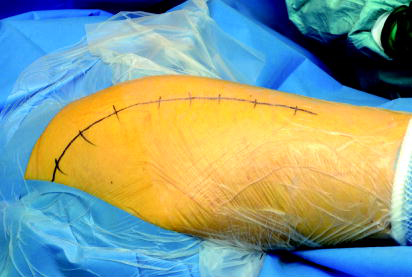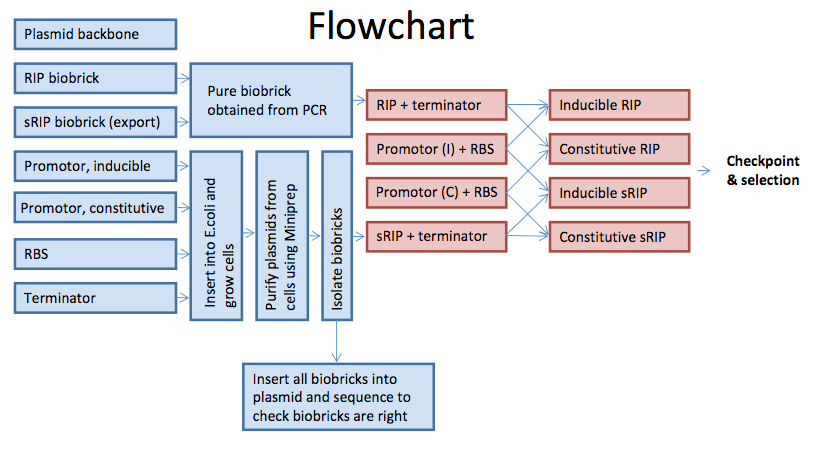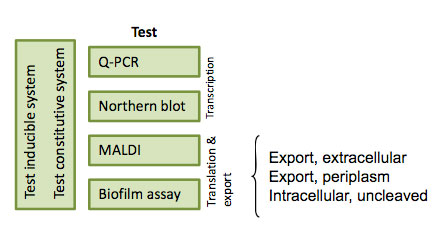Team:SDU-Denmark/Project
From 2009.igem.org
(→Methods) |
(→Methods) |
||
| Line 66: | Line 66: | ||
4. Transformation into competent E.coli ([https://2009.igem.org/Team:SDU-Denmark/Protocols#Electroporation Protocol]). | 4. Transformation into competent E.coli ([https://2009.igem.org/Team:SDU-Denmark/Protocols#Electroporation Protocol]). | ||
| - | + | ==Testing== | |
| - | + | [[Image:SDU-Denmark-flowchart03.jpg|250px|thumb|right|Flowchart concerning our testing phase.]] | |
| + | To test if our 4-brick inserted into E.coli it functioning, we have prepared 3 different systems: gene expression by measuring mRNA expression, MALDI to measure protein expression and a actual test of quorum quenching. The system is testing at different levels, and we thereby hope to be able to back-track the error if some of the systems aint working properly. | ||
| - | == | + | ===Colony PCR=== |
| - | [ | + | We started by testing our part lengths by colony PCR ([https://2009.igem.org/Team:SDU-Denmark/Protocols#Protocol_for_colony_PCR Protocol]). |
| + | ===Sequencing=== | ||
| - | + | We sent our parts to sequencing to be sure, that we had exactly the right DNA in our bacteria. We used the Plasmid editor [[Team:SDU-Denmark/Tools|APE]], to see our sequencing data. | |
===RNA expression=== | ===RNA expression=== | ||
Revision as of 15:04, 21 October 2009

Concept
Bacto-Bandage
The concept of our project is to assemble biobricks in to a plasmid and in this way get E. Coli to produce and excrete the quorum quenching protein RIP.
We propose making a bandage that contains our engineered bacteria behind a semipermeable membrane, allowing only small peptides such as RIP to pass through, into the wound.
We have reason to hope, that this will weaken the biofilm, thereby making multiresistant bacteria easier to treat with conventional antibiotics. This will increase the effectiveness of the antibiotics and thereby diminish the amount and range of antibiotics that needs to be used in order to fight the infections.
Parts
Our idea is to compose a plasmid containing a promoter, which should either be constitutive or inducible. After the promoter sequence we have a RBS, and then our RIP sequence, which we composted from the amino acid sequence of the protein and made in PCR via two costumed primers. We are working with a clean RIP sequence and a RIP sequence with an export sequence on it. After the RIP sequence we have a terminator. It all has to be incorporated into an ampicillin resistant plasmid backbone.
We considered trying with two different promotors, since we do not know whether a high concentration of RIP will quorum quench the E. Coli itself. It will there for be practical for us to control the rate of transcription - hence the inducible promoter. On the other hand we know that a higher concentration of RIP is more efficient in quorum quenching S. Aureus, and it will therefore be more efficient if the plasmid is transcribed at all times. Furthermore if the export of the protein out of the cell is weak, an overproduction of the protein might puncture the cell and RIP will leak out. This will of course kill the cells, but they could be replaced. Our goal is to get as much “RIP” exported from the bandage to the wound one way or another.
Methods
Finding parts
Ligations
As seen in the flow chart, the parts [http://partsregistry.org/wiki/index.php?title=Part:BBa_K237000 RIP] and [http://partsregistry.org/wiki/index.php?title=Part:BBa_K237003 sRIP] where the first to be produce and ligated into backbone ([http://partsregistry.org/Part:pSB1A3 pSB1A3]). Afterwards RIP and sRIP is ligated with a terminator ([http://partsregistry.org/Part:BBa_B0015 BBa_B0015]) resulting in a two brick. We are using a constitutive promoter that is already assembled with a RBS ([http://partsregistry.org/wiki/index.php?title=Part:BBa_J13002 BBa_J13002]) and a inducible promoter ([http://partsregistry.org/wiki/index.php?title=Part:BBa_R0011 BBa_R0011]) that we assemble with a RBS binding site ([http://partsregistry.org/wiki/index.php?title=Part:BBa_B0034 BBa_B0034]) Finally the 4-bricks is constructed.
1. Amplification by PCR using [http://partsregistry.org/Part:BBa_G00100 VF2] and our modified [http://partsregistry.org/Part:BBa_K237007 VR] primer (Protocol).
2. Digest with fast digest restriction enzymes, upstream part with SpeI and downstream part with XbaI (Protocol).
3. Ligate with T4 DNA Ligase, resulting in a mixed site (Protocol).
4. Inserted parts into backbone.
Inserting parts in backbone
The steps was as following:
1. Amplification by PCR using [http://partsregistry.org/Part:BBa_G00100 VF2 primer] and our modified [http://partsregistry.org/Part:BBa_K237007 VR2 primer] (Protocol).
To skip a bacerial growth step, and thereby save some time, our parts where amplified by PCR, as suggested in [http://ginkgobioworks.com/support/BioBrick_Assembly_Manual.pdf Ginkgo Bioworks assembly manual]
2. Digesting with fast digest restriction enzymes EcoRI-HF™ and PstI (Protocol).
We used fast digest enzymes, since normal enzymes where either slow or ineffective in cutting our bricks.
3. Ligated with T4 DNA Ligase (Protocol).
4. Transformation into competent E.coli (Protocol).
Testing
To test if our 4-brick inserted into E.coli it functioning, we have prepared 3 different systems: gene expression by measuring mRNA expression, MALDI to measure protein expression and a actual test of quorum quenching. The system is testing at different levels, and we thereby hope to be able to back-track the error if some of the systems aint working properly.
Colony PCR
We started by testing our part lengths by colony PCR (Protocol).
Sequencing
We sent our parts to sequencing to be sure, that we had exactly the right DNA in our bacteria. We used the Plasmid editor APE, to see our sequencing data.
RNA expression
To measure if RNA is beeing expressed the are using northern blotting (See protocol). We are using a radioactive probe (32P) that binds to RIP mRNA. The probe is added to a membrane in which the RNA i run size- wise, and the probe is binding to the RNA containing the RIP sequence. The membrane it put on a film, that can store the radioactive phosphor, the film is scanned and we can thereby visualize if any accumulation of radioactive phosphor has taken place.
Test of quorum quenching
To test if our 4-brick inserted into E.coli it functioning and RIP is secreted out of the cell, we are designing a quorum quenching test system. The system is being made on a 4*6-well plade. Different S.aureus strains is growing in the wells making biofilms. Inhibition of biofilm formation is tested with different E.coli components added to the different wells: supernatant, crushed pellet and living E.coli. After 24 hours of growing the wells are washed three times with sterile 1xPBS to remove planktonic bacteria. Cells remaining adhered to the wells are subsequently stained with violet blue, the solution stands for 15 minutes and is again washed twice. A mixture of ethyl alcohol and acetone is added to each stained well to losen the biofilm, the biofilm is tested by measuring the absorbance by transfering the crystal violet/ethanol solution from each well to a cuvette, and measure the optical density (OD) of each of these samples at a wavelength of 595 nm.
MALDI
Matrix-assisted laser desorption/ionization (MALDI) is a technique used in mass spectrometry, allowing the analysis of for example proteins.
Results
New parts and primers
We have successfully constructed the RIP and sRIP parts, and used these with older parts, all of which have been added to the registry. We have also added a slightly modified VR primer to the registry.
RIP expression in E. coli
We have successfully assembled a 4-brick part containing a constitutive promotor with RBS, our novel RIP part and a terminator.
Both sequencing and a northern blot analysis confirmed that our E. coli indeed expresses RIP. To our knowledge this is the first time a recombinant E. coli can produce RIP. We also did a MALDI mass spectrometry which didn't show anything conclusive, perhaps as a consequence of RIP's small size.
Quorum-quenching and biofilm inhibition
We are currently testing the quorum-quenching effect on S. aureus biofilm and the results are promising. The big question is whether or not, RIP gets exported out of E. coli and past the peptideglycan layer and capsule. The final results will be presented at the Jamboree.
Implications
Contents |
 "
"


